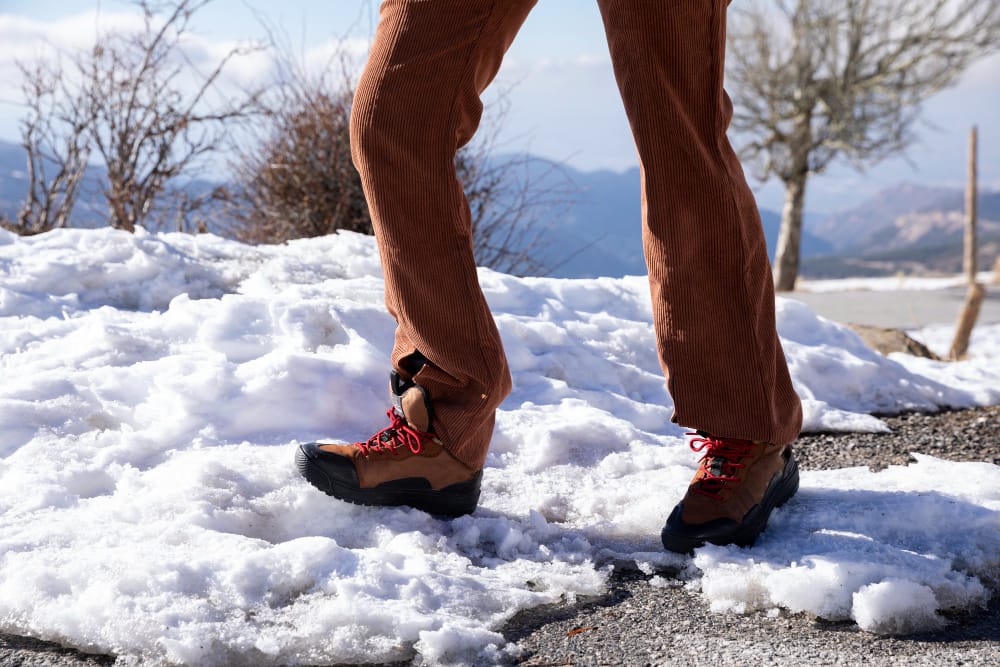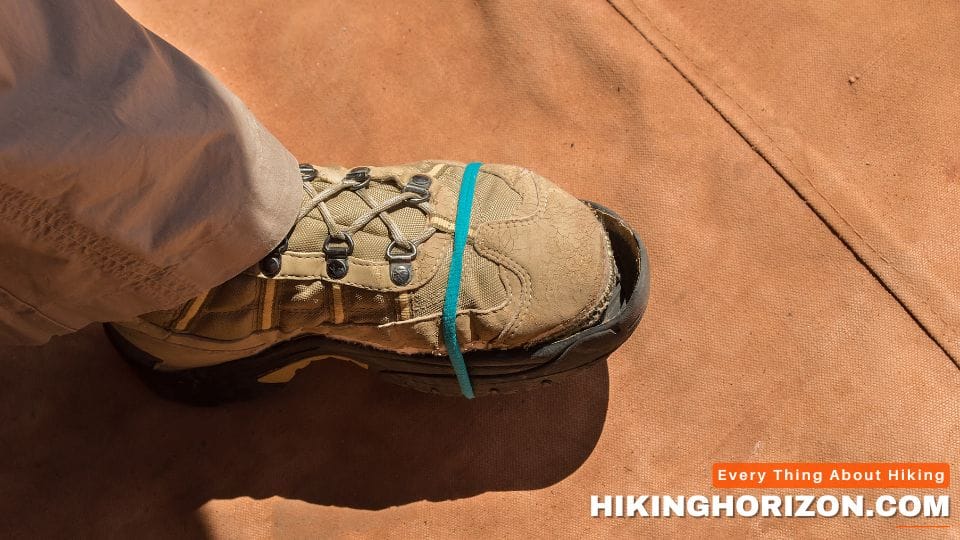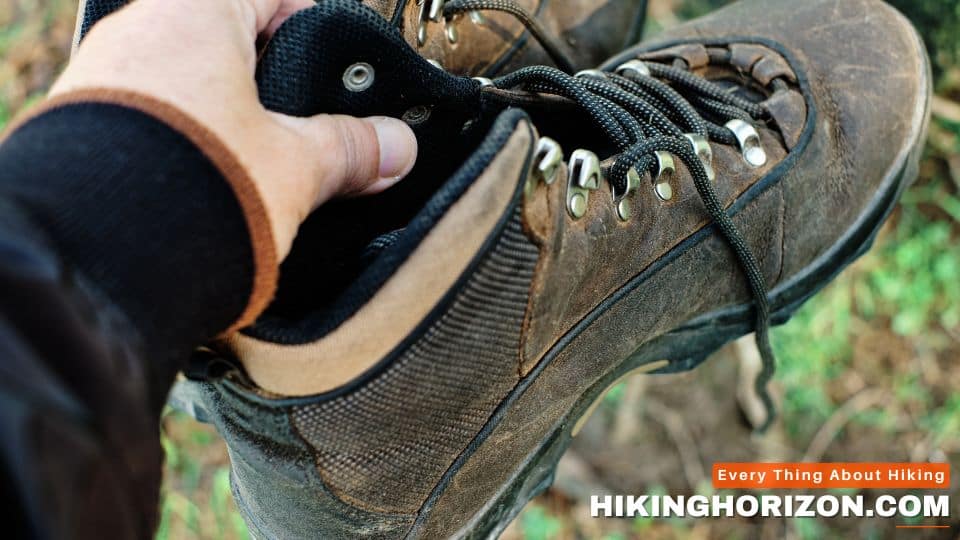

Hiking boots and snow boots are two popular footwear for outdoor enthusiasts. However, when it comes to winter conditions, Adventure enthusiasts and nature lovers often wonder can hiking boots be used as snow boots.
The answer to the question of can hiking boots be used as snow boots is yes in certain conditions. Winter sports enthusiasts often ask if hiking boots can double as snow boots. The question is not as simple as it may sound because the type of hiking boots you have and the amount of snow you expect to encounter are significant factors to consider.
Table of Contents
Differences Between Hiking Boots And Snow Boots
To understand whether hiking boots can be used as snow boots, let’s first look at the differences between these two types of footwear.

Hiking Boots
Designed for long walks on rough terrain Provide ankle support and protection against rocks and roots Made with breathable materials to keep feet dry and comfortable Offer traction on uneven surfaces

Snow Boots
Designed specifically for cold, wet, and snowy conditions Insulated to keep feet warm in sub-zero temperatures Waterproof construction to keep feet dry Provide traction on slippery, icy surfaces
As you can see, some key differences between hiking boots and snow boots exist. But that doesn’t mean you can’t use your hiking boots in the snow.
Can Hiking Boots Be Used As Snow Boots?
Although hiking boots are not specifically designed for snow, they can be used in certain snowy conditions with some modifications. If you’re wondering whether your hiking boots are good for walking in the snow, there are a few things to keep in mind:
"Don't let anyone tell you that hiking boots can't be used as snow boots. With the right preparation, anything is possible."
Insulation and Warmth
Hiking boots typically do not have the same level of insulation as snow boots. It means your feet may get cold quickly, especially in extremely low temperatures. To combat this issue, wear thick, warm socks made of wool or synthetic material that wicks moisture away from your skin.
Pro tip: Look for hiking boots that are labeled as “insulated” or “winterized” if you plan on using them in cold weather. These boots typically have added insulation and are designed for use in low temperatures.
Waterproofing
Waterproof or water-resistant hiking boots can help keep your feet dry when walking through snow. However, they may not be as effective as snow boots in keeping your feet dry in deep, wet snow or slush. Gaiters, which are protective sleeves that cover the top of your boots and lower legs, can help keep snow and water from entering your boots.
Traction
Hiking boots generally have good traction on uneven terrain but may not provide enough grip on icy or slippery surfaces. You can use traction devices like microspikes or crampons that attach to the bottom of your boots to improve traction. These devices provide additional grip on ice and packed snow.
When It Is Okay To Use Hiking Boots As Snow Boots
If you decide to use your hiking boots as snow boots, there are some things you should keep in mind. Here are some scenarios where it is okay to use your hiking boots as snow boots:


Light Snow
If you are walking around town or going on a short hike in light snow, your hiking boots may be suitable. Ensure your boots are waterproof, and wear warm socks to keep your feet warm.
Packed Snow
Your hiking boots may be suitable if the snow is packed down and not too deep. The traction on your boots should be sufficient for packed snow, but make sure to wear warm socks to keep your feet warm.
Snowshoeing
If you are planning on snowshoeing, your hiking boots may be suitable. Make sure your boots are waterproof, and wear warm socks. You may also consider using gaiters to prevent snow from getting into your boots.
When You Should Not Use Hiking Boots As Snow Boots


While hiking boots can be adapted for snowy conditions, they are not a perfect substitute for snow boots. If you plan on spending significant time in cold, snowy environments or participating in winter sports like snowshoeing, skiing, or snowboarding, investing in a pair of snow boots is a smart choice. Snow boots offer better insulation, waterproofing, and traction, specifically designed for winter conditions.
Here are a few situations where snow boots are the better option:
- Deep snow: If you are trekking through deep snow, snow boots provide better coverage and protection against moisture.
- Extreme cold: Your hiking boots may not be warm enough in extremely low temperatures. Snow boots offer superior insulation to keep your feet warm and comfortable.
- Prolonged exposure to wet conditions: Snow boots are designed to keep your feet dry even in wet, slushy conditions, making them a better choice for extended periods in the snow.
- Ice: If you are going to be walking on ice, your hiking boots may not provide enough traction. Snow boots are designed with slip-resistant soles that provide maximum traction on ice.
- Winter sports: If you’re participating in winter sports or activities, such as snowshoeing, skiing, or snowboarding, snow boots are specifically designed for these purposes and provide better performance than hiking boots.
"Your boots may be made for hiking, but they can also handle the toughest winter weather."
Expert Opinions On Using Hiking Boots As Snow Boots
To provide a well-rounded perspective, let’s explore what some outdoor experts have to say on the matter.
“When it comes to using hiking boots as snow boots, I’ve found that a well-insulated, waterproof pair can make all the difference. I’ve faced many snowy trails and stayed warm and dry with just my trusty hiking boots.”
“I believe that hiking boots can be used as snow boots as long as they provide enough insulation, support, and traction for the specific conditions you’ll be facing. It’s essential to know your gear and its limitations.”
“While hiking boots might not be specifically designed for snow, I’ve successfully used them with the right accessories, like gaiters and traction devices in winter. It’s about adapting your gear to meet your needs.”
“Using hiking boots as snow boots can be a practical solution for many outdoor enthusiasts. Just make sure to prioritize waterproofing and insulation and to assess the specific weather conditions before heading out.”
“In my experience, a high-quality pair of hiking boots can double as snow boots when paired with the right socks, gaiters, and traction devices. The key is to be prepared and to understand the limits of your gear.”
The Pros and Cons of Using Hiking Boots in Snow
Now that we’ve established the key differences between hiking and snow boots, let’s consider the advantages and disadvantages of using hiking boots as snow boots.
"Hiking boots may not be designed for the snow, but they can still help you reach new heights."
Pros of Using Hiking Boots in Snow
- Traction: Hiking boots often have grippy soles that can handle slippery, snow-covered surfaces.
- Ankle support: The support provided by hiking boots can help you navigate uneven terrain and reduce the risk of injury.
- Durability: Hiking boots are built to withstand rough terrain and harsh conditions, so they should hold up well in the snow.
- Cost-effective: If you already own a pair of hiking boots, using them in the snow can save you the expense of buying snow boots, which can be quite expensive, especially if you opt for a high-end brand.
- Versatility: Hiking boots can be used in various conditions and terrains, making them a versatile option for outdoor enthusiasts.
- Environmentally Friendly: Most snow boots are made with synthetic materials that take a long time to decompose, while hiking boots are often made with natural materials such as leather and rubber that are biodegradable. By choosing hiking boots over snow boots, you can reduce your carbon footprint and make an eco-friendlier choice.
Cons of Using Hiking Boots in Snow
- Insulation: Hiking boots typically lack the insulation needed to keep your feet warm in extremely cold conditions, making them less suitable for extended periods in the snow.
- Water resistance: While many hiking boots are water-resistant, they may not be fully waterproof. It could let moisture seep in, leading to cold and wet feet.
- Height: Most hiking boots have a lower cut than snow boots, allowing snow to enter the boots when walking through deep snow.
- Limited protection: Hiking boots may not provide adequate protection from snow and ice buildup around the ankles and lower legs, increasing the risk of frostbite or discomfort.
- Less Traction on Ice: While hiking boots offer decent traction on snow, they may not grip as well on icy surfaces. In contrast, boots specifically made for snow are created to give you more grip and stability when you’re walking in snowy conditions.
- May not fit crampons: If you plan to use crampons for added traction on ice, you must ensure your hiking boots are compatible with them.
Tips for Using Hiking Boots in Snowy Conditions


If you decide to use your hiking boots in snowy conditions, follow these tips to stay safe and comfortable:
Invest in Quality Hiking Boots
Choose a pair of well-constructed hiking boots that feature a waterproof or water-resistant upper. Look for models with Gore-Tex or other waterproofing technologies to ensure your feet stay dry.
Waterproof Your Boots
If your hiking boots aren’t already waterproof, consider using a waterproof spray or wax to add a protective layer against moisture.
Layer Your Clothing
Dress in layers to stay warm and dry in cold, snowy conditions. It will help keep you comfortable even if your boots aren’t providing optimal insulation.
Layer your socks
As mentioned earlier, wearing warm, moisture-wicking socks is crucial for keeping your feet warm in cold weather. Pair your hiking boots with socks designed for cold weather. Opt for socks made from moisture-wicking materials like merino wool, which can help keep your feet warm and dry. Brands like Smartwool and Darn Tough offer quality cold-weather socks.
Choose waterproof boots
Opt for hiking boots with a waterproof or water-resistant construction to keep your feet dry in wet snow.
Add Insulating Insoles
Consider adding a pair of insulated insoles to your hiking boots for added warmth. Many insoles, such as those made by Superfeet or Thermacell, are specifically designed for cold conditions and can provide an extra insulation layer.
Use gaiters
Gaiters are a valuable accessory for keeping snow out of your boots. By attaching them to your boots and covering your lower legs, gaiters create a barrier that prevents snow from entering your footwear. Outdoor Research and Black Diamond offer reliable gaiter options.
Attach Crampons
Crampons are metal spikes that attach to the bottom of your boots and provide extra traction on icy surfaces. They are often used for mountaineering and ice climbing but can also be useful for hiking in snowy conditions. Crampons are not recommended for use with hiking boots, but some models are designed to fit over hiking boots.
Add Traction Devices
Equip your hiking boots with microspikes, crampons, or other traction devices for better grip on slippery surfaces.
Check the Weather
Before venturing out in the snow, check the weather forecast and make sure your hiking boots will suit the conditions. If temperatures are extremely low or there’s a risk of heavy snowfall, it might be best to invest in proper snow boots.
Be Cautious
Even with these modifications, your hiking boots may not perform as well as snow boots in extreme conditions. Use caution and be prepared to turn back or change your plans if conditions become too challenging.
FAQs
Q.1 Can hiking boots be used in light snow?
A. You can wear hiking boots when there’s a little snow, but they might not keep your feet warm enough or give you enough traction if there’s a lot of snow.
Q2. Are snow boots more expensive than hiking boots?
A. Snow boots can be more expensive than hiking boots because they are designed for extreme weather conditions and have additional features like insulation and waterproofing.
Q3. Can gaiters be used with hiking boots?
A. Yes, gaiters can be used with hiking boots to keep snow and water out of the boots.
Q4. What type of socks should I wear with snow boots?
A. Wool socks are a good choice for cold weather because they provide excellent insulation and can wick moisture away from your skin.
Q5. Are crampons necessary for winter hiking?
A. Crampons are not always necessary for winter hiking but can be useful in icy conditions or for more advanced hiking and mountaineering.
Q6. Can hiking boots be waterproofed?
A. Hiking boots can be treated with waterproofing sprays or other products to make them more water-resistant, but they may not be completely waterproof.
Q7. How do I know if snow boots fit properly?
A. Snow boots should fit snugly to prevent snow and cold air from getting inside. It’s important to try them on with the socks you plan to wear to ensure a proper fit.
Q8. Can hiking boots be used for snowshoeing?
A. Hiking boots can be used for snowshoeing, but snowshoeing boots are designed to provide better support and traction on snowshoes.
Q9. Can snow boots be used for hiking in the summer?
Snow boots are designed for winter weather conditions and may be too warm and heavy for hiking in the summer.
Q10. How do I choose the right pair of snow boots?
A. Consider factors like insulation, waterproofing, traction, fit, and the type of socks you’ll wear when choosing a pair of snow boots.
Personal Experience
I’ve been an outdoor enthusiast for years and have used hiking and snow boots for various winter activities. While snow boots are undoubtedly the best choice for snowy conditions, I have occasionally used hiking boots. I find that they work well for shorter hikes or activities that don’t require prolonged exposure to snow and cold.
However, snow boots are my go-to choice when it comes to more prolonged exposure to snow and cold. They offer better insulation, water resistance, and traction, making them the ideal choice for snowshoeing or winter hiking activities.
Conclusion
In conclusion, hiking boots can be used as snow boots, but it depends on several factors, such as insulation, sole, and fit. If you already have hiking boots and want to use them for winter activities, make sure to choose boots with ample insulation and a sole designed for snow and ice. It’s also crucial to use proper socks and consider adding gaiters or traction devices for extra protection and grip.
However, if you plan on spending a significant amount of time in snowy conditions, investing in a pair of snow boots specifically designed for winter activities is best. Snow boots offer better insulation, water resistance, and traction, making them the ideal choice for longer adventures in the snow. Whatever your choice, make sure to prioritize warmth, comfort, and safety for all your winter adventures.

MARK RODRIGUEZ
Mark is an experienced backpacker who has completed several multi-day hikes, including the John Muir and Wonderland Trail. He is also a hobbyist photographer who delights in capturing the captivating essence of nature through his camera lens. Mark is passionate about environmental conservation and often volunteers for trail maintenance and clean-up projects.

MARK RODRIGUEZ
Mark is an experienced backpacker who has completed several multi-day hikes, including the John Muir and Wonderland Trail. He is also a hobbyist photographer who delights in capturing the captivating essence of nature through his camera lens. Mark is passionate about environmental conservation and often volunteers for trail maintenance and clean-up projects.




What are the key differences between hiking boots and snow boots in terms of design and purpose?
Here are some of the key differences between hiking boots and snow boots:
In summary, hiking boots prioritize traction, support, and durability for the trail, while snow boots focus more on insulation, waterproofing, and light weight for winter weather.
Appreciate exploring the key factors in determining if my hiking boots can also work for snowy conditions – waterproofing, insulation level and traction. A very helpful guide as I plan cold weather adventures and know whether special winter boots are a wise investment.